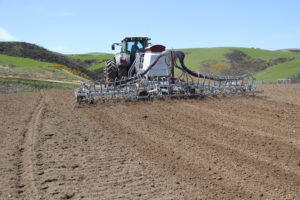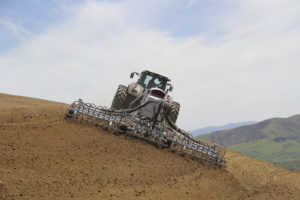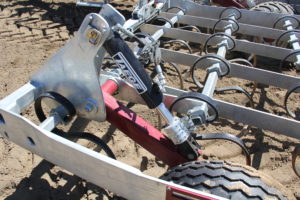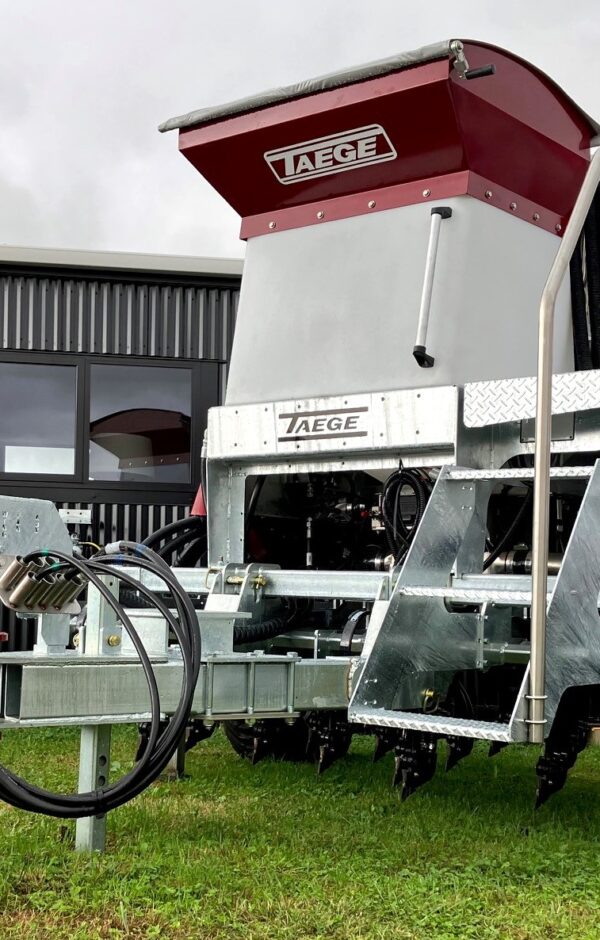Jaiden Drought from Farm Trader checks out a Taege 8m cultivator at Beaumont Station in Central Otago.
Recently I got to visit one of the largest privately owned stations in New Zealand: Beaumont Station, owned by the Hore family. At 28,000ha, it’s a big slice of dirt. So what brought me to this wonderful part of Central Otago? The Taege eight-metre cultivator with seed hopper – part prototype, part hillside climbing cultivator.
Now I say prototype quite loosely, really, as it is not a new machine; it’s a slightly heavier version of the six-metre cultivator with an extra metre added to each wing to become the eight-metre cultivator. Everything else is the same.
To confuse the matter even more slightly, it is not the same as a six-metre cultivator on steroids either as the seeder on this machine uses the same hopper (only one but is space for two in the existing frame). Metering and the in-cab controller (and seed hopper camera) are all the same but instead of going to distributing towers and down individual tyne tubes this particular version is simply broadcast from 30 outlets between the last set of tynes and the rear mounted tyne harrows.
KEY FEATURES
Phased rams: This ensures all rams lift simultaneously at the headland which creates a nice finish both at the headland and the start/end of each run.
S-tynes: These create the shacking effect combined with the Tyne angle allow these to bite into very hard ground which would only be possible with very heavy disc drills. These can be fitted with tungsten tips which are very hard wearing and when compared to disc drills in terms of running costs per ha drills the difference between them is thousands, probably tens of thousands of dollars.
Tyne spacing: 69 tynes on the eight metre cultivator/seeder with 115mm spacing which gives a total drilling width of 7.93 metres. The folding wings with clever trip latches ensure the wings float in the field but are stable on the road and fold up within the three metre road width, although height may be an issue with the wings on public highways.
Ram spacing: A number of different sized clip-ons go on the ram and with various different combinations on the rams (the inner rams are larger) can give drilling depth control to within 3mm between clip combinations.
Tyne harrows: Standard two rows fitted, tyre roller optional.
Metering system: A combination of stainless steel, foam and plastic components in the metering system means corrosive and abrasive fertiliser will not cause any damage
Hydraulic fan: The fan has a soft start valve which will not let any more oil the 47L/min through which will ensure the hydraulic drive motor will last for years longer as it will not be stationary one second and the next have 150L/min at 200 bar from the tractors hydraulics.
CALIBRATION
Calibration is as follows:
1. Open the stainless steel grate on the venturi, place the small metal bagging shoot in the open slot and place the nice purple seed tray underneath.
2. Select the sowing rate (kg/ha on the monitor) and hit the prime button on the monitor (which plugs in by the hopper so you don’t have to run in and out of the cab). All the prime button does is ensure the metering system is primed with product.
3. Empty the priming discharge into the hopper so the seed tray is empty.
4. Hit the calibrate button on the monitor, this will automatically discharge material for 20 seconds (although this can be altered as small seeds you would want to discharge for 40-odd seconds to have a more accurate weigh sample).
5. Weigh the contents and punch this number into the monitor, you are ready to drill, it really is that simple, no charts, calculators or even maths, it simply works it all out for you however for a simple check of accuracy Taege recommend you do one more step.
6. Hit run on the drill and manually turn the ground wheel the replicate 100th of a hectare on the monitor and weigh the contents, if you wanted 25kg/ha and you have 250g, you are bang on and now you are 100 percent certain you have the correct calibration and are confident to go drilling.
THE VERDICT
Pros
– Lower hp requirements while still maintaining a large working width keeping running costs per ha low.
– Accuracy of an airseeder but low weight of broadcast system.
– Excellent build quality.
– Kiwi made.
– Electronic calibration which is very simple.
– Magnetic wheel encoder which is more reliable and accurate than radar and GPS.
– Own metering system with only stainless, plastic and foam means it will not suffer corrosion from fertiliser.
– Phased rams give tidy equal lift at headlands.
– 115mm row spacing.
– Variety of tip options.
Cons
– These wings are big, perfect for this situation where the machine will never leave the farm but for more common contractor use with the full seeding kit, trust me, you will know it is coming towards you




